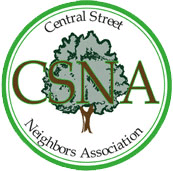Bike Parking Spots in Demand on Central St.
Biking is healthy for both the globe and our glutes. But if, as predicted, more people start riding bikes instead of driving, they'll have a tough time finding places to lock their two-wheeler on Central Street. Both the City and local businesses may not realize just how many folks already bike, not just for recreation, but for transportation.
The first picture here shows the rack just east of the Central Street Metra station, on Poplar. It's usually full by 9:00 if not earlier. The second picture here shows the rack at Chase Bank, the only other significant space near the Metra for locking up. It too is full on any bikeable day. At that point every street sign, parking meter, or lightpost becomes a target for Kryptonite. Note: click either pic to see a bigger version.
West of the Metra, racks are in short supply. There are none at Independence Park or directly in front of public facilities like the Post Office or library. Three small racks, each able to hold about 3 or 4 bikes, can be found on Hartrey just outside Great Harvest, on the NW corner of Central and Stewart (kitty-corner from the library), and on Prairie just outside Coventry Eye. The first two are too far to be useful for train commuters, and the one on Stewart is camouflaged by dark metal and rust. I doubt most folks know it's there. Note that those 3 small racks are on side streets.
Altho there are plenty of places to park an SUV right on Central itself, as well as a municipal lot with 48 spaces, there is not one bike rack on a sidewalk directly on Central Street between Hartrey and Chase Bank. As a result, bikers running errands or shopping on Central are more likely to lock up at meters or lightposts. That works for the biker, but especially where there are news boxes, this can cause a little clutter.
It's easy to see that interest in biking is on the uptick all over Evanston and Chicagoland. The racks inside the Davis Street L station are well-used, even in winter. With gas prices unlikely ever to be back at levels we saw just a couple years ago, that trend will continue. But right now the infrastructure is not in place for the switch.
When there are racks, often they're inadequate for urban American reality. Sadly, thieves prey not only on whole bikes, but on removable parts. That means the old ladder-type racks we had on our schoolyards as kids, where you could just lock your front wheel up and feel secure, won't work. Do that now and you might return to find your wheel locked to the rack and the rest of the bike missing. And anything less than the heaviest-duty lock renders a nice bike susceptible.
Bike racks and bike lanes serve a purpose even when unused. Changing habits takes time, partly because the message that an alternative is possible takes a while to sink in. Installing bike infrastructure sends that repeated message. If society and government want people to drive less, we have to start making a conscious and concerted effort wherever possible at the little things that promote a less car-dependent existence.
Forums:
- Log in to post comments
